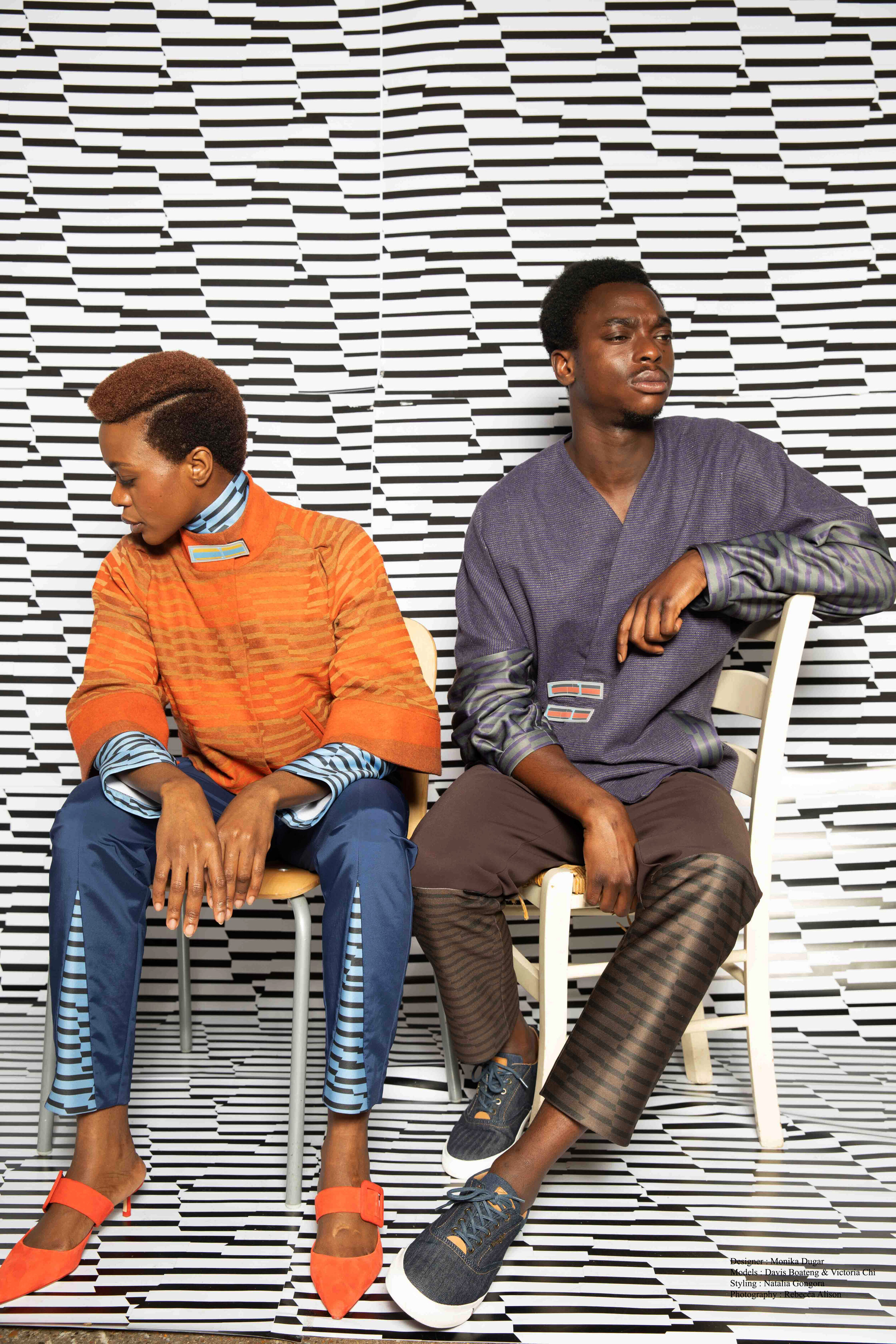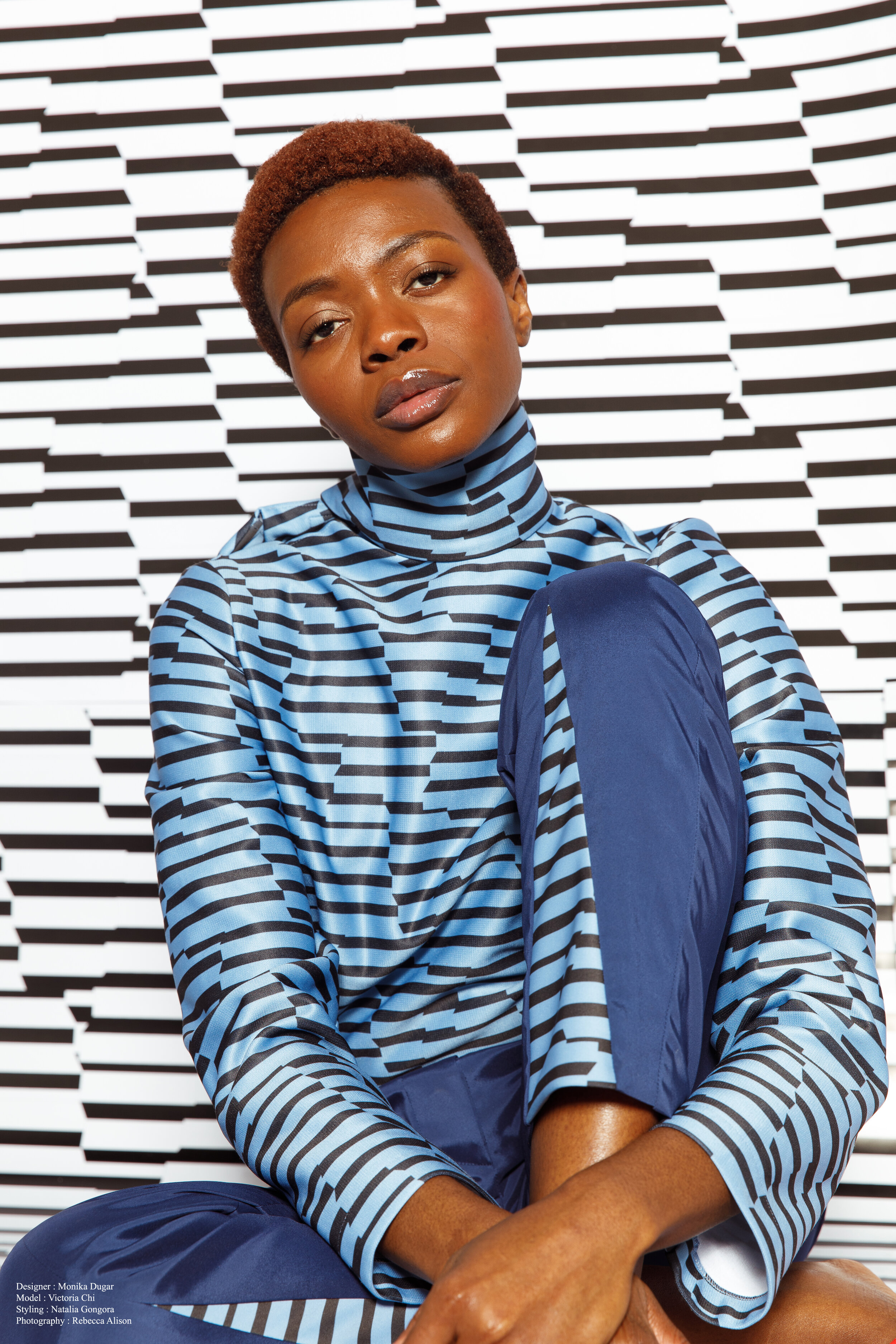WoW Woman in FashionTech and HealthTech | Monika Dugar, fashion designer
Interview by Marija Butkovic MarijaButkovic
Monika, what is the idea behind your project / product and how did you come up with it?
I became involved in researching the condition, after my father was diagnosed with Parkinson’s 6 years ago. The hand tremors, stiffness and slow movement associated with Parkinson’s disease made the dressing routine pesky and difficult for him. During my course at London College of Fashion, I was exploring a market that sits at the niche of the transformation of the fashion in an ageing generation and disabled, which motivated me to work on [R E S E T]. My collection is inspired by the concept of Visual Control of Locomotion in Parkinson’s disease, Brain: A Journal of Neurology – which is where I found that when someone with Parkinson’s looks at certain patterns, it could improve their mobility through visual cues. This reignited me to design the collection, which not only is influential but features patterns which could aid mobility in people with Parkinson’s. The collection reinvents conservative adaptive clothing by providing a sense of freedom and a new vision.
Designing for differently-abled is not a trend, it’s a necessity. Balancing fashion through functional clothing will empower people and advocate for inclusiveness – that’s the aim.
What was the biggest obstacle?
Being an adaptive clothing start up in the fashion industry, an untapped market, there is lack of access to multifaceted skills and resources to establish the Adaptive wear in the market. Brand recognition, scaling up and getting the funding is the biggest obstacle I’m facing.
Clothing plays an important part of living well with differently abled, as the choice of clothes, in particular, can affect symptoms. Due to restrictive mobility these choices can crucially impact whether they can operate functionally. Restrictive clothes and fabrics can really exasperate or trigger the freeze response or other symptoms. This includes the all important "look" and "self-confidence" factors alongside that of functionality, something which is currently missing from the market.
Education holds key to the future of Adaptive wear, fashion colleges still don’t encourage enough to design adaptive clothing, brands & press don’t want to collaborate, as mostly prefers glamorous fashion clothing, basing on the notion of Disability-friendly clothing will be boring or sacrifice stylishness, which certainly is not the case anymore.


What are your biggest achievements to date?
My biggest accomplishment to date by creating a collection, which is not just for aesthetic impact — they're meant to aid mobility in people with Parkinson's disease by "resetting" the brain. The collection reinvents conservative adaptive clothing by providing a sense of freedom and a new vision. Raising awareness, making clothing more inclusive because features, design, print and colours can help people with differently-abled to gain confidence bringing humanness at every level will allow them to be more independent and highly valued.
I’ve always been inspired by the unique experiences that people with disabilities have during my artistic career at London College of Fashion, which came from when I started making my designs personal and started reflecting on them. I communicated my observation with my point of view through the designs, which is a process of innovation, problem solving and empathising with them.
When you start questioning your designs it naturally incurs into every single design you make. Just ask yourself, Will your design solve the purpose? Who is it for? Is it doing justice through the design? You create your own USP as you start discovering yourself. It has been eye- opening for her, to see how small changes to clothing could make such a difference to someone’s life. It gives me a profound sense of satisfaction if I can change someone’s life through my work.
What are your projects you are currently working on?
I’m constantly experimenting, instigating new methods and updating research within [R E S E T]. Not everyone has the same problems with dressing, so I want the clothing to engage with a range of different people’s needs.
Researching new innovative products with a combination of wearable technology and fashion are the ways through which [R E S E T] will provide solutions. Intensive analysis on materials will focus on developing new multifunctional surfaces and materials with tailored properties and predictable performance for new products and processes as well as for their repair. In addition, I’m exploring the Wearable technology and how it can be integrated to the garments. Studying the Techniques from all aspects of textile design construction, performance and easy washable and breathable fabrics made to ensure high performance i.e. elasticity and full adaptability. The basis for innovation in this area will be new knowledge and its application towards sustainable production and consumption patterns.
Also, I’ve been nominated for Parkinson’s UK Charity Show to raise money for Parkinson research, Exhibiting for the Charity called The Cure Parkinson’s Trust along with 10 exclusively invited British-based Fashion Designers (already confirmed Hussein Chalayan, Roksanda, Giles Deacon and others) is an inspirational and dynamic organisation with a major goal to slow, stop and ultimately find a cure for PD.
What will be the key trends in the fashion tech and wearable tech industry in the next 5 years and where do you see it heading?
The paradigm is currently shifting and fashion, which bore a stigma of disfigurement is becoming more inclusive. With the consumption increase and marketing industry focusing on dispelling the stereotype for ageing, the current scenario for wearable tech is at the storming and norming stage. With Fashion focused on ageing and size, this will bring disruption in the industry in order to revolutionise and address the issues faced by differently-abled consumers. The extraordinary combination of textile and electronic fabrication technologies that can add value to the wearer by sensing stimuli from the environment, reacting and adapting to them by integration of functionalities in the textile structure. Another upcoming trend is Sensor wearability, which has excellent bio-functionality furnishing medical devices with various smart functions such as biocompatibility, biodegradability, and self‐healing. Sensor-embedded smart clothes, which will help in improvement of minimising the fatigue and skin trouble felt by users due to long-term wearing.
What is the most important piece of advice you can give to all female founders and female entrepreneurs out there?
Lean In. Never give up in spite of the challenges and obstacles. Recognize the value of what you are trying to create. In the inevitable turbulence of the world of startups, remind yourself how important it is to be centered in yourself, your values, and your beliefs. Find your purpose. Be confident, women entrepreneurs have unique and powerful perspectives to offer every industry.
Who are your 3 inspirational women in fashion tech and / or wearable tech?
Grace Jun, Sinead Burke, Lucy Jones.These are the designers who have inspired me to work for the Adaptive Clothing market, especially with differently-abled to strengthen creative practices.
Connect with Monika on LinkedIn!
Find out more about Monika’s projects:
- https://www.dezeen.com/2020/01/09/monika-dugar-reset-parkinsons-clothing-fashion/
- https://parkinsonslife.eu/monika-dugar-parkinsons-clothing/
- http://www.platform-mag.com/fashion/monika-dugar.html
- https://www.boldsky.com/fashion/trends/monika-dugar-s-collection-reset-for-people-with-parkinson-s-disease-132275.html
This interview was conducted by Marija Butkovic, Digital Marketing and PR strategist, founder and CEO of Women of Wearables. She regularly writes and speaks on topics of wearable tech, fashion tech, IoT, entrepreneurship and diversity. Follow Marija on Twitter @MarijaButkovic.

